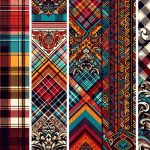I've always been intrigued by the intricate patterns of a tartan plaid, like the iconic Royal Stewart tartan worn by the British royal family.
But have you ever wondered about the story behind these designs? The origins of tartan plaids are steeped in rich history and tradition, with each pattern holding its own unique symbolism and significance.
Join me as we unravel the fascinating tale of tartan plaids, exploring their evolution, cultural impact, and modern-day relevance. Stay tuned to discover the hidden layers of meaning woven into these timeless textiles.
Table of Contents
Key Takeaways
- Tartan plaids symbolize clan affiliation and Scottish pride.
- They reflect historical and cultural significance through unique patterns.
- Tartans connect individuals to their heritage and ancestral roots.
- Modern trends blend traditional tartans with innovative designs in fashion and decor.
Origins of Tartan Plaids
The fascinating history of tartan plaids dates back centuries, revealing a rich tapestry of cultural significance and tradition. The origins of tartan plaids can be traced to the Scottish Highlands, where these distinctive patterns were initially used to identify different clans and regions. Over time, tartan evolved from a practical means of recognition to a symbol of Scottish heritage and pride.
The development of tartan plaids involved intricate weaving techniques that varied depending on the desired pattern. Traditional tartans were created using a method called 'twill weaving,' which produces distinctive diagonal lines in the fabric. Additionally, color choices played a significant role in the design of tartan plaids, with different regions and families often having their unique combinations that held specific meanings.
Understanding the origins and development of tartan plaids provides insight into the rich cultural history behind these iconic patterns. The weaving techniques and color choices used in creating tartan plaids reflect the diversity and individuality of the clans and regions they represent, making them a cherished symbol of Scottish heritage.
Symbolism and Significance
Let's explore the rich symbolism and significance behind tartan plaids.
These patterns not only represent a cultural heritage but also serve as a tradition for clan identification.
Understanding the deeper meanings woven into each tartan can offer a glimpse into the history and pride of those who wear them.
Cultural Heritage Representation
Peering into the intricate patterns of a tartan plaid reveals a tapestry of cultural heritage woven with symbolism and significance. Tartan plaids hold a rich history, representing different clans, regions, and even professions in Scotland. Beyond just a fashion statement, these patterns carry the weight of heritage preservation and cultural identity. The colors and arrangements in a tartan can signify various meanings, from familial connections to historical events. Exploring tartan in modern wear not only reflects a nod to tradition but also a celebration of timeless style. Let's explore further into the cultural significance of tartan plaids through the table below:
| Meaning | Symbolism | Significance |
|---|---|---|
| Clan affiliation | Family ties | Ancestral pride |
| Regional identity | Geographic roots | Cultural belonging |
| Occupation indication | Professional background | Historical significance |
Clan Identification Tradition
Exploring further into tartan plaids leads us to the tradition of Clan Identification, where the symbolism and significance of these patterns connect individuals to their ancestral roots and heritage. Understanding clan traditions and fabric history helps reveal the rich tapestry of meanings woven into each unique tartan design.
Here are three key aspects of Clan Identification Tradition:
- Symbolism: Tartan plaids symbolize the unity and kinship of a specific clan, reflecting shared values and history.
- Heritage Connection: Wearing a clan tartan is a way to honor one's lineage and ancestors, fostering a deep sense of belonging and pride.
- Historical Significance: These patterns carry the legacy of generations, preserving cultural identity and traditions through fabric.
Evolution of Tartan Patterns
The evolution of tartan patterns showcases the rich history and cultural significance woven into each intricate design. Tartan patterns have a fascinating design evolution, originating from the traditional tartans worn by Scottish Highlanders. Initially, tartans were associated with specific regions rather than clans. Over time, as the use of tartan fabric became more prevalent, certain patterns became linked with particular clans, reflecting their historical significance and identity.
As the demand for tartan increased, especially during the Victorian era, the variety of patterns expanded. Tartan designs became more elaborate, incorporating an array of colors and intricate motifs. This evolution of tartan patterns reflects not only changes in fashion trends but also the cultural adaptations that occurred over centuries.
The historical significance of tartan patterns lies in their ability to symbolize unity, heritage, and social identity. Each variation carries a unique story, representing a blend of tradition and innovation that continues to captivate audiences worldwide. The evolution of tartan patterns stands as a proof to the enduring legacy of Scottish culture.
Tartan Plaid in Scottish Culture
Tartan plaids hold a special place in Scottish culture, rooted in the country's history and traditions.
The origins of Scottish tartans can be traced back centuries, with each clan having its own distinctive pattern symbolizing their identity and heritage.
Understanding the significance of tartan in Scotland helps unravel the intricate layers of this beloved cultural symbol.
Scottish Tartan Origins
In Scottish culture, the intricate patterns of tartan plaid hold a significant historical and cultural importance.
- Fabric Weaving: Tartan plaids are traditionally made from wool and woven in a way that creates distinctive patterns.
- Historical Patterns: Each tartan design is associated with specific clans, regions, or institutions, with some patterns dating back centuries.
- Cultural Significance: Tartan plaids played a crucial role in Scottish history, symbolizing family ties, social status, and even political allegiances. The intricate weaves and colors of tartan plaids aren't just fabric patterns but living symbols of Scotland's rich heritage and identity.
Understanding the origins and meanings behind these historical patterns adds depth to the appreciation of tartan plaids in Scottish culture.
Tartan Symbolism in Scotland
Symbolizing centuries of heritage and identity, tartan plaids intricately weave together the rich tapestry of Scottish culture. Scottish pride is deeply embedded in the vibrant patterns of tartan, each design reflecting a specific clan or region.
This traditional attire holds immense significance in Scotland, symbolizing unity, belonging, and history. Wearing a particular tartan can signify allegiance to a specific Scottish clan or simply showcase pride in one's Scottish roots.
The colors and patterns of tartan plaids are a visual representation of the diverse landscapes and histories that make up Scotland. From formal events to everyday wear, tartan remains a powerful symbol of Scottish identity, connecting people to their past and fostering a sense of community and pride.
Global Influence of Tartan
With its distinctive patterns and rich history, tartan plaid has made its mark on cultures worldwide, becoming a beloved symbol of heritage and style. The global influence of tartan can be seen through:
- Fashion Trends: Tartan has transcended its Scottish roots to become a staple in fashion around the world. From high-end designers to streetwear brands, tartan patterns continue to grace runways and clothing racks, showcasing its enduring appeal.
- Cultural Appropriation: While tartan has been embraced by many cultures, there have been instances of cultural appropriation where the significance and history of tartan have been misrepresented or exploited. Respecting the origins of tartan and understanding its cultural significance when incorporating it into various contexts is crucial.
- Symbol of Rebellion: Tartan has also become a symbol of rebellion and non-conformity in global youth culture. Its association with countercultural movements has further solidified its place as a timeless and iconic pattern that continues to captivate audiences worldwide.
Modern Interpretations and Uses
As we explore modern interpretations and uses of tartan plaid, it's fascinating to see how this timeless pattern continues to evolve and adapt to contemporary fashion and cultural trends. In today's world, tartan plaid remains a versatile and popular choice, with designers incorporating it into a wide range of fashion trends and contemporary styles. From classic tartan scarves and skirts to more unconventional uses in accessories and even home decor, the creative applications of tartan plaid are endless.
Innovative designs have pushed the boundaries of traditional tartan, introducing new color combinations, scales, and even materials to reinvent this iconic pattern. High fashion runways showcase tartan in unexpected ways, blending it with modern silhouettes and cutting-edge techniques to create a fresh and exciting look. Additionally, streetwear brands and independent designers have embraced tartan plaid, infusing it with a youthful and urban flair that appeals to a diverse audience.
Whether it's a subtle nod to heritage or a bold fashion statement, tartan plaid continues to captivate and inspire with its adaptability and timelessness in contemporary design.
Frequently Asked Questions
How Are Tartan Plaids Traditionally Worn in Scottish Culture?
Traditionally, tartan plaids are worn in Scottish culture as part of traditional attire on ceremonial occasions. They hold deep significance and reflect clan heritage. I find the colors and patterns fascinating, embodying history and pride.
Are There Specific Rules or Traditions Regarding the Colors and Patterns Used in Tartan Plaids?
When it comes to tartan plaids, color symbolism plays a significant role in Scottish tradition. Different hues represent various aspects like clans or regions. Additionally, distinct tartan patterns are associated with specific families, showcasing their heritage and history.
Are There Any Superstitions or Beliefs Associated With Wearing or Owning a Tartan Plaid?
Wearing tartan plaids has long been tied to superstitions and beliefs, adding depth to their fashion appeal. From warding off evil to symbolizing clan loyalty, these patterns connect me to historical figures and cultural traditions.
How Has the Perception of Tartan Plaids Changed Over Time in Different Regions Around the World?
Over time, cultural perceptions of tartan plaids have shifted, influenced by global trends and regional variations. Fashion evolution has played a significant role in transforming how these patterns are viewed and embraced worldwide.
Are There Any Famous Individuals or Historical Figures Known for Their Association With Tartan Plaids?
Famous figures and historical associations are often intertwined with tartan plaids. Their impact on fashion and culture is undeniable. From royalty to rebels, tartan has woven its way into the fabric of history.
- The Use of Nonwovens in Construction and Civil Engineering - July 11, 2025
- The Use of Nonwovens in Construction and Civil Engineering - July 11, 2025
- The Use of Nonwovens in Construction and Civil Engineering - July 11, 2025







